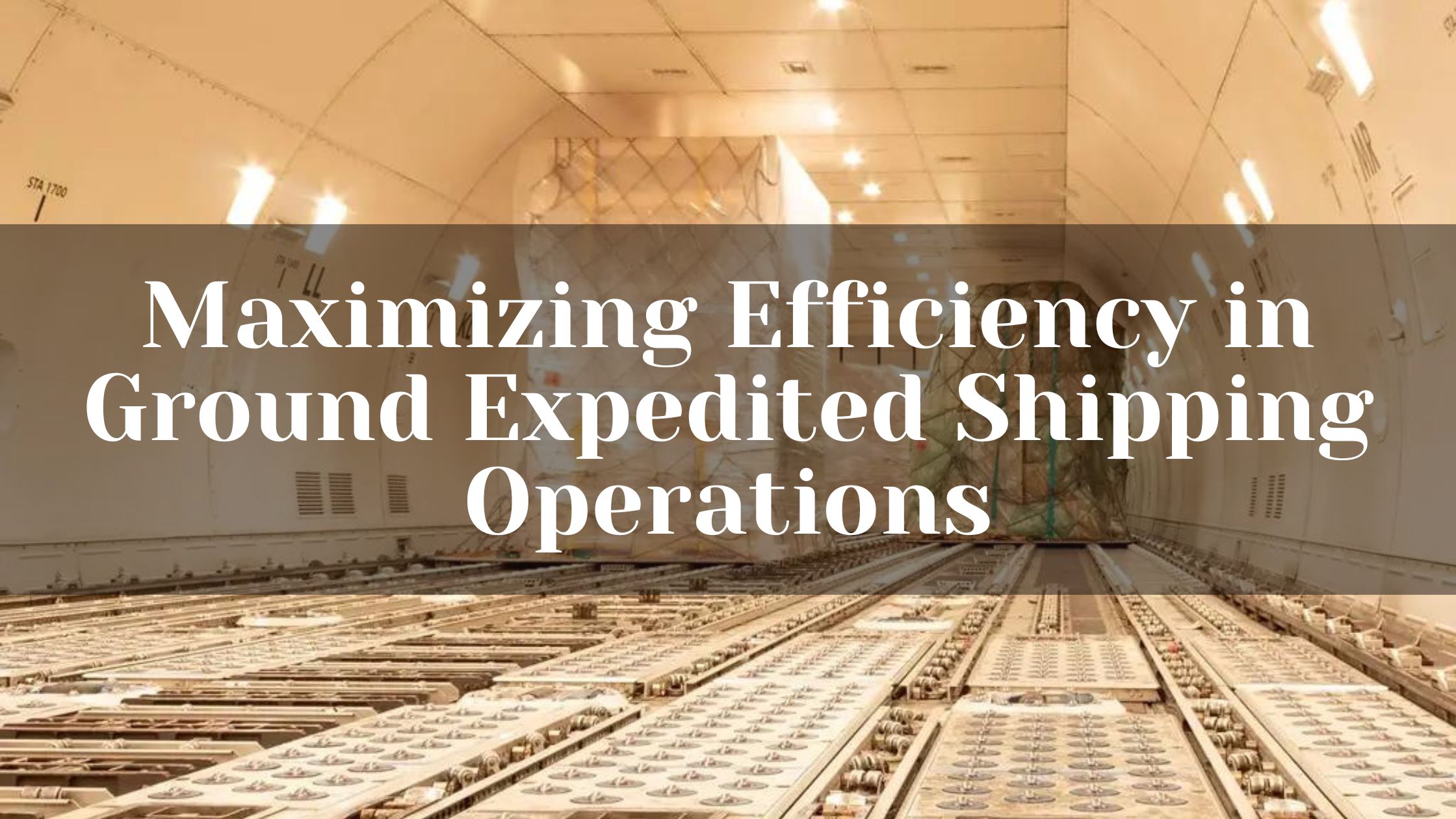
Introduction
In today’s fast-paced world, efficiency in ground expedited shipping isn’t just a goal—it’s a necessity. Whether you’re a logistics manager or a business owner, understanding how to streamline your shipping operations can save time, reduce costs, and enhance customer satisfaction. This article dives deep into the strategies and technologies that can help maximize efficiency in ground-expedited shipping operations. Ready to rev up your shipping game? Let’s get started!
Understanding Ground Expedited Shipping
Definition and Purpose
Ground expedited shipping is a method designed to move goods quickly via ground transportation. Unlike standard shipping, expedited services prioritize speed, ensuring that packages reach their destinations faster. It’s the go-to solution for urgent deliveries that can’t wait for standard timelines.
Comparison with Other Shipping Methods
While air and sea freight have their own advantages, ground expedited shipping strikes a balance between speed and cost-efficiency. It’s faster than sea freight and more cost-effective than air freight, making it a popular choice for many businesses.
Key Factors Influencing Efficiency
Transportation Infrastructure
A robust transportation infrastructure is the backbone of efficient shipping operations. Well-maintained roads, reliable highways, and accessible distribution centers all play crucial roles in ensuring timely deliveries.
Fleet Management
Managing a fleet efficiently means having the right number of vehicles, ensuring they are in good condition, and deploying them strategically. Effective fleet management reduces downtime and maximizes the use of available resources.
Route Optimization
Choosing the best routes can significantly impact delivery times and fuel consumption. Route optimization involves using data and technology to find the quickest, most efficient paths for deliveries.
Technological Innovations
GPS Tracking Systems
Gone are the days of guessing delivery times. GPS tracking systems provide real-time updates on vehicle locations, allowing companies to monitor progress and make adjustments as needed.
Automated Warehousing
Automation in warehouses streamlines operations, from inventory management to order fulfillment. Automated systems can sort, pack, and dispatch goods faster and more accurately than manual processes.
AI and Machine Learning in Logistics
Artificial intelligence and machine learning are revolutionizing logistics. These technologies analyze vast amounts of data to predict demand, optimize routes, and improve decision-making processes.
Effective Fleet Management
Regular Maintenance Schedules
Keeping vehicles in top condition is crucial for minimizing breakdowns and delays. Implementing regular maintenance schedules ensures that all fleet vehicles are ready for the road.
Driver Training Programs
Well-trained drivers are more efficient and safer. Regular training programs help drivers stay updated on best practices, safety protocols, and new technologies.
Fuel Efficiency Strategies
Fuel is a significant cost in shipping operations. Strategies such as route optimization, maintaining proper tire pressure, and using fuel-efficient vehicles can lead to substantial savings.
Route Optimization Techniques
Real-Time Traffic Monitoring
Using real-time traffic data helps avoid congestion and delays. Traffic monitoring tools provide up-to-date information, allowing drivers to choose alternative routes when necessary.
Dynamic Routing Algorithms
Dynamic routing algorithms adjust routes on the fly based on current conditions. These algorithms consider factors like traffic, weather, and road closures to find the most efficient paths.
The Role of Big Data
Big data plays a critical role in route optimization. By analyzing historical data, companies can predict traffic patterns, identify bottlenecks, and plan more efficient routes.
Improving Warehousing Operations
Inventory Management Systems
Efficient inventory management ensures that products are available when needed. Advanced inventory systems track stock levels in real-time, reducing the risk of shortages or overstocking.
Automated Sorting and Packing
Automation in sorting and packing speeds up the fulfillment process. Automated systems can handle high volumes of orders quickly and accurately, reducing labor costs and human error.
Cross-Docking Strategies
Cross-docking minimizes storage time by transferring goods directly from inbound to outbound trucks. This strategy reduces handling costs and speeds up the delivery process.
Leveraging Data Analytics
Predictive Analytics for Demand Forecasting
Predictive analytics uses historical data to forecast future demand. Accurate demand forecasting helps companies plan inventory levels and allocate resources more effectively.
Real-Time Data Monitoring
Monitoring data in real-time provides immediate insights into operations. Companies can identify issues as they arise and make quick adjustments to maintain efficiency.
Decision-Making Based on Analytics
Data-driven decision-making leads to better outcomes. By leveraging analytics, companies can identify trends, optimize processes, and improve overall performance.
Enhancing Customer Communication
Real-Time Shipment Tracking
Customers appreciate transparency. Real-time shipment tracking allows customers to monitor their packages’ progress and receive updates on estimated delivery times.
Automated Notifications and Updates
Automated systems can send notifications and updates to customers, keeping them informed throughout the shipping process. This enhances customer satisfaction and reduces inquiries.
Responsive Customer Service
Responsive customer service is vital for handling inquiries and resolving issues promptly. Investing in customer service training and tools ensures that customers receive the support they need.
Sustainability Practices
Green Logistics Initiatives
Adopting green logistics practices helps reduce environmental impact. Initiatives such as using electric vehicles and optimizing delivery routes contribute to sustainability.
Reducing Carbon Footprint
Minimizing carbon footprint involves using energy-efficient vehicles, reducing idle times, and implementing eco-friendly practices throughout the supply chain.
Sustainable Packaging Solutions
Sustainable packaging reduces waste and supports environmental goals. Using recyclable materials and minimizing packaging size are effective strategies.
Staff Training and Development
Continuous Learning Programs
Continuous learning ensures that staff stay updated on industry trends and best practices. Regular training programs help employees develop new skills and improve efficiency.
Safety and Compliance Training
Safety and compliance are paramount in shipping operations. Training programs focused on safety protocols and regulatory compliance help prevent accidents and ensure adherence to laws.
Enhancing Productivity
Investing in staff development enhances productivity. Skilled employees perform their tasks more efficiently, leading to better overall performance.
Collaborative Partnerships
Working with Reliable Carriers
Choosing reliable carriers ensures that goods are handled and delivered efficiently. Building strong relationships with carriers can lead to better service and reliability.
Integrating with Third-Party Logistics
Third-party logistics providers offer expertise and resources that can enhance operations. Integrating with these providers allows companies to leverage their capabilities and improve efficiency.
Collaborative Planning and Forecasting
Collaborative planning with partners ensures alignment and improves accuracy in forecasting demand and resources. This cooperation leads to smoother operations and better outcomes.
Regulatory Compliance
Understanding Legal Requirements
Staying informed about legal requirements is crucial for compliance. Companies must understand the regulations governing their operations to avoid penalties and disruptions.
Ensuring Adherence to Regulations
Compliance involves following all relevant laws and regulations. Regular audits and training help ensure that operations meet legal standards.
Impact of Compliance on Operations
Compliance impacts various aspects of shipping operations, from safety to documentation. Adhering to regulations ensures smooth operations and avoids legal issues.
Conclusion
Maximizing efficiency in ground-expedited shipping operations involves a combination of technology, strategic planning, and continuous improvement. By focusing on fleet management, route optimization, data analytics, and customer communication, companies can achieve significant gains in efficiency. The future of shipping lies in embracing innovation and sustainability, ensuring that operations are both effective and environmentally friendly.
FAQs
Q: What is the difference between expedited and regular ground shipping?
Ans: Expedited shipping prioritizes speed, ensuring faster delivery times compared to regular ground shipping. It’s ideal for urgent shipments that need to reach their destination quickly.
Q: How does route optimization improve efficiency?
Ans: Route optimization uses data and technology to find the most efficient paths for deliveries, reducing travel time and fuel consumption, leading to faster and more cost-effective shipments.
Q: What role does technology play in expedited shipping?
Ans: Technology plays a crucial role in enhancing efficiency through GPS tracking, automated warehousing, AI-driven analytics, and real-time data monitoring. These innovations streamline operations and improve decision-making.
Q: How can companies ensure sustainability in shipping operations?
Ans: Companies can adopt green logistics practices, use energy-efficient vehicles, reduce carbon footprints, and implement sustainable packaging solutions to ensure environmentally friendly shipping operations.
Q: What are the benefits of collaborative partnerships in logistics?
Ans: Collaborative partnerships with reliable carriers and third-party logistics providers enhance service quality, improve resource allocation, and ensure better planning and forecasting, leading to more efficient operations.



